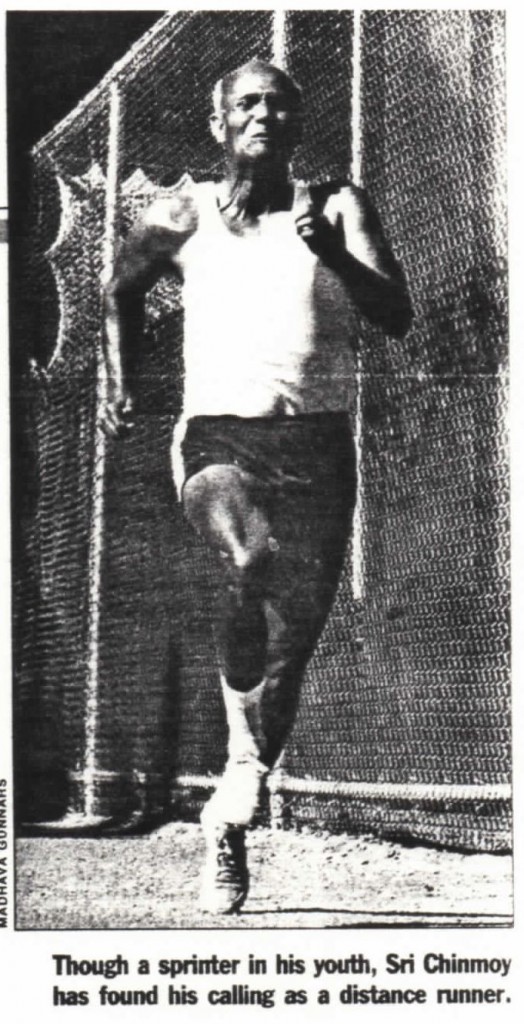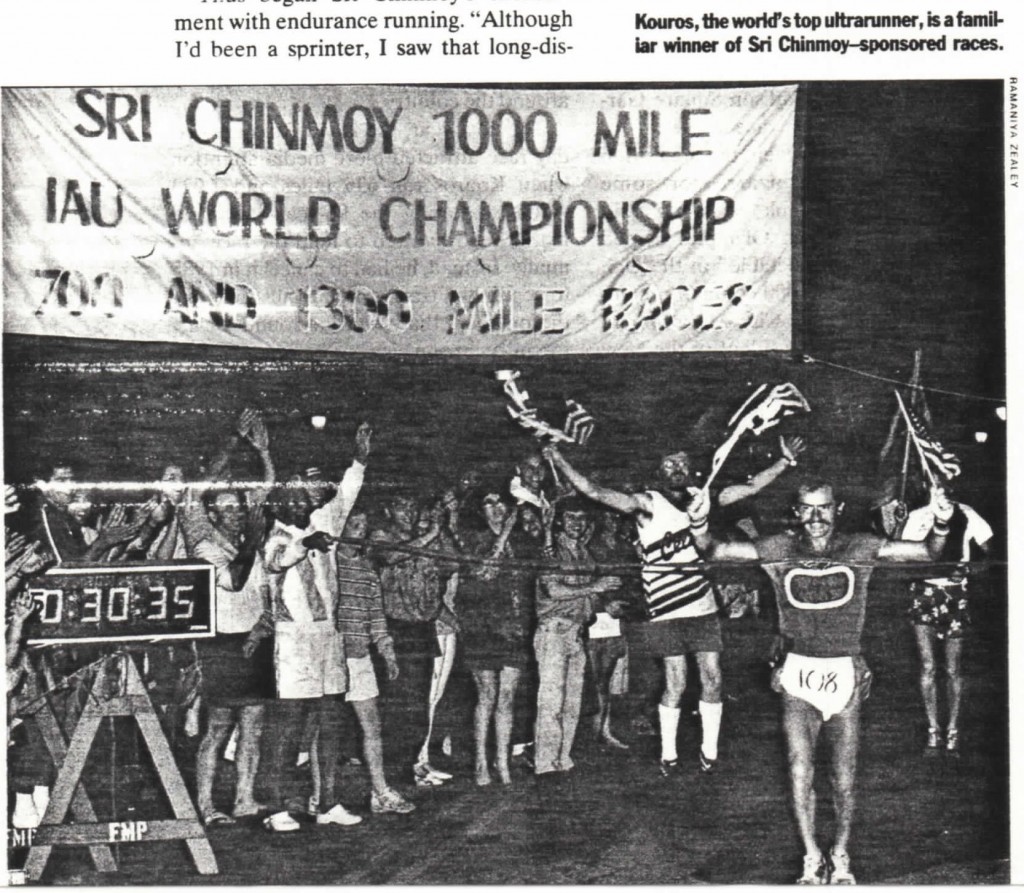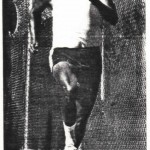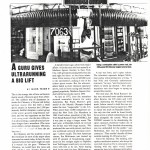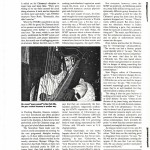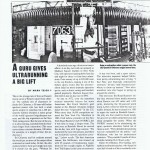1990 – Ultrarunning’s Big Lift – USA Sports Illustrated May 28 issue
Filed under media coverage Text & Photos | MG Members in other events | Sport & AthleticsThe peace meditations at the UN led by Sri Chinmoy were briefly mentioned in the midst of a 3 page article on ultra Running in the popular USA 28 May 1990 magazine ” Sports Illustrated”.
Excerpt below:
…’ tale of how an Eastern mystic saved a Western sport from oblivion.
The unlikely mix of characters includes Sri Chinmoy, a 58-year-old Indian spiritual master …; a select group oi the world’ s greatest long-distance runners; and the top organizers on the New York racing scene. But the star of the story is ultrarunning, a catchall term for footraces longer than a marathon. (The races cover either a certain distance, 100 miles, for example or a length of time: the six-day race.
Sri Chinmoy and his students around the world put on most of the major ultras contested on roads today. In fact, the elite runners believe their sport might not exist if it weren’t for the guru. “Without Sri Chinmoy, we would have few races and little future,” says Yiannis Kouros of Greece, the world’s top ultrarunner. “He has been the sport’s lifeline.”
A hundred years ago, ultras were major affairs. A six-day race sold out annually at Madison Square Garden in New York City, with spectators paying hefty fees day and night for three- or four-hour admissions. Prize money of up to $25,000 went to the top finishers. making it one of the richest sports events. But the ultramarathon faded as more dramatic spectator sports, such as horse racing and baseball, gained popularity. Madison Square Garden held its last six-day race in 1896.
As late as 1972, even the marathon seemed somewhat bizarre for some Americans. But Frank Shorter’s gold medal at the (1972) Munich Olympics helped make the race “respectable” in the U.S. When more than 14,000 competitors entered the New York City Marathon in 1982, Fred Lebow, president of the New York Road Runners Club (NYRRC), felt it was time to stage a longer event. The next year, at Randalls Island, he revived the six-day race with huge success. “We marketed the race with pizzazz, and there was worldwide network television coverage,” Lebow recalls. The best American runner, Stu Mittleman, was trussed up with 25 pounds of broadcasting equipment for five straight nights so Nightline host Ted Koppel could carry on conversations with him as he ran. After staying back in the pack for days Mittleman rewarded Nightline with a stirring second place finish
..The next year, the Road Runners’ six day race attracted more media attention when Kouros ran 635 miles and 1,023 yards, shattering the 96-year-old world mark. Lebow vowed to hold the race annually. Instead, he had to cancel it in 1985 to repair the track on Randalls Island the only site that could be found locally for an event at which competitors eat and sleep alongside the course. When the NYRRC seemed to be abandoning the sport, sponsors elsewhere bailed out of races as well…
Enter Sri Chinmoy. .. softspoken meditation teacher, who … hardly seems the type to be obsessed with athletics. But during his youth, he was sprinting and decathlon champion of the religious retreat (ashram) in Bangladesh where he was raised. He was convinced that sports were one path to peace and godliness. …He churned out a prodigious amount of devotional songs, poems and paintings, as well as a few hundred books of essays and meditation lessons.
He established 80 Sri Chinmoy Meditation Centers worldwide and led twice-weekly “peace meditations” for United Nations personnel.
In 1976, … his disciples put together the mammoth Liberty Torch Relay, a nonstop, 8,8oo-mile relay through all 50 states to celebrate the Bicentennial….coast-to-coast goodwill (resulted).
“Although I’d been a sprinter, I saw that long-distance running was better for most people,” he says. … they could easily develop stamina by practicing a few months.” he started distance running himself … (he eventually ran 22 marathons and seven ultras),
“Ultra distance runners have to spend hours training every day,” he explains. “As a result, they receive many good things from Above: patience, inner tranquility, consecration and a self-disciplined and dedicated life.” Moreover. ultrarunning seemed a perfect metaphor for his philosophy of self-transcendence- the idea that through “deep inner and outer striving,” one could go beyond “the restrictions imposed by the mind” and discover unlimited potential.
The theory was soon put to the test. On Sri Chinmoy’s 47th birthday in 1978, a group of his students decided to run a 47-mile race in celebration. ” Ultras were still completely obscure then, and … “Only a few had even run a marathon. … By reasonable estimates. all the runners eventually should have collapsed or broken into pieces. Instead. out of 50 who began the run, 49 finished.
Two years later the SCMT first public ultramarathon. a 24-hour race in Greenwich, Conn. …
They helped out at countless local events, methodically winning the hearts, mind and advice of running’s top organizers, such a Lebow and former Olympian Ted Corbitt. .. When the NYRRC started seriously promoting the 100-mile and six-day races it relied on Sri Chinmoy’s disciples to count laps and keep time. “They were willing to be out there around the clock doing whatever it took, and we depended on them more and more,” says NYRRC treasurer Peter Roth….
When the NYRRC cancelled its six-day race in 1985 for good, Sri Chinmoy decided to sponsor an event that stretched the imagination even further- a 1,000 mile road race. The event, established the SCMTs style: …part peace demonstration, but mostly one of unflagging personal attention. … The Marathon Team made sure the runners could concentrate on running… working eight- to-12-hour shifts counted laps and manned the clock. Others worked in the nearby miniature Olympic Village they themselves had built. Mostly at their own expense (defrayed partly by 5200 entrance fees), they had installed a telephone system, hot and cold showers, a clothes dryer, sleeping facilities, a kitchen cooking individualized vegetarian meals round-the-clock, and a medical tent staffed with masseurs, exercise physiologists and chiropractors.
In the next couple of years, Sri Chinmoy brought this same organizational panache to a growing list of events: a 70-mile race, a loo-mile race, a five-day race, a seven-day race, a 7oo-mile race and finally, a 1,3OO-mile race-said to be the longest running event ever held…. Many of the world and national records for men and women have been set in these events, and Ultra running magazine, the sport’s bible, says that they are consistently the best handled anywhere. .. the International Association of Ultrarunners approved the 1988 Sri Chinmoy 1,000-mile run as a world championship, and The Athletics Congress (the U.S. governing body of road racing) sanctioned the 1989 24-hour and 100-mile races as U.S. championships. Perhaps surprisingly, no one seems happier about all this than Lebow. “They took an un-remunerative burden off our hands. Even if we could afford to step in, there would be no reason : Sri Chinmoy is doing a very good job.”
…I am at God’s behest,” (Sri Chinmoy) says. “I listen to the dictates of my inner being, and whatever He asks, I try to do with devoted oneness. This is why I do ultradistance.” It’s also why he doesn’t care if sponsors stay away” their financial concerns might only interfere with the intimate atmosphere and precision of his races. And as for making ultras commonplace, that’s precisely his point – to show that the common man can regularly accomplish the impossible. As long as runners want to run, says Sri Chinmoy, he expects to keep putting on ultras. “God does not like anything good to disappear from creation,” he says. “So He will not let ultradistance running disappear. If He sees that I am not doing well, He can choose another instrument to carry out His will.”
• Mark Teich is a free-lance writer who lives and runs in New York City.
Click on image below for different resolution or larger photo-images:
- 1990-05-may-28-sports-illustrated-usa_Page_1
